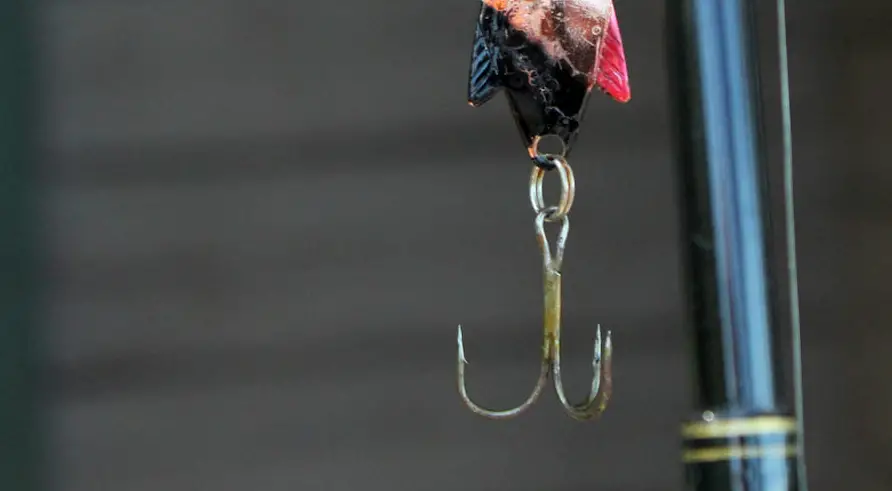Yes, there’s a difference between hook and chorus in popular songs. (Just wanted to get that out of the way…)
We all instinctively know what the chorus is: the section of a song that’s usually the loudest, catchiest, and most memorable. It’s the highlight of the song and often contains lyrics quoting the song title.
Then, there’s the idea of a hook: any repeating song element that catches your attention. (You know… Like how a hook catches a fish?)
So, what’s the difference between a hook and a chorus? Basically, not all hooks are choruses, but pretty much all choruses are hooks! A song can have multiple hooks, but typically only has one chorus (which is repeated throughout the song).
Put another way? The chorus usually consists of a lead vocal hook, but hooks can be so much more than that:
- Rhythmic. Beats, claps, percussion.
- Instrumental. Bass riffs, guitar riffs, synths, pan flutes… you get the idea.
- Vocal. Backing vocal parts, hums, whistles, or non-lexical vocables (ie la la’s and na na’s).
Hook vs Chorus
Now, why does it matter whether you use the term “hook” vs “chorus” anyway? After all, they’re just words – and music is still music regardless of how you talk about it!

Well, the terminology you use is important because it helps you communicate with others about music.
There are some poor souls who use the terms “hook” and “chorus” interchangeably, referring to the “hook” of the song when they really mean the “chorus.”
I know… but I’m sure these people mean well!
Anyway, now you know that hooks in songs can show up anywhere, anytime, like a secretive ninja or a spy leaping out of the shadows – and before you know it, you’ve been hooked! (I think that’s how that works.)
But rather than listen to me ramble on about it, let’s hear what some of the best songwriters of the past half-century have come up with for hooks!
Improve your songwriting by mastering piano.
$49
ONLY
5 Popular Hooks to Learn From
The best way to get familiar with hooks and choruses is to listen to them in action. That’s why I’ve pulled together five great examples of hooks in popular songs!
Now, I know it’s cliched, but I’m going to have to start with the Beatles for this.
…Why?
Because almost every one of their most popular songs has multiple hooks, especially on guitar – those four lovable Brits must have thought instrumental hooks were fabulous!
Hook Example 1: Day Tripper
The central hook for Day Tripper is a sparkly electric guitar riff (with a matching bass part) that plays under most of the song. It shifts in pitch as the chord progression goes and takes a break during the chorus, but it MAKES the song!
Arguably, if you told someone to hum the melody from Day Tripper, they would probably start with the instrumental riff over the chorus – it’s THAT memorable!
There are a ton of other Beatles songs that are similarly “hook-y,” such as “Here Comes the Sun,” which has a multi-bar guitar hook that later becomes the vocal melody of the song. This hook provides the underlying structure for every part of “Here Comes the Sun.”
I challenge you to go listen to a random Beatles song. You’ll quickly realize how important instrumental hooks were to their success!
Hook Example 2: Ghostbusters Theme
I know, it’s pretty much the most “80’s song” in existence, but I was always impressed by how many different hooks the Ghostbusters Theme song had all layered together.
If you don’t believe me, take a listen!
It has a main instrumental hook that’s carried at various times by electric guitar, synth, and saxophone/brass. Then, there’s a guitar/synth breakdown at the end of each chorus, plus a pretty catchy vocal melody – who can forget the “Who you gonna call? Ghostbusters!” shouted at the end of each line?
It’s downright spooky how catchy this song is. There’s a reason we still sing it forty years later and keep it in our Halloween playlists!
Hook Example 3: Under Pressure
Ignoring the “Ice, Ice, Baby” controversy, can we just marvel at the incredible bass hook in “Under Pressure? It’s one of the most iconic hooks ever made: doo-doo-doo-da-da-doo-doo!
From the start, this intro hook is quickly layered with some electric guitar noodling, a few piano notes, and the impeccable vocals of Freddie Mercury and David Bowie.
This is an example of a song where the chorus itself is overshadowed by the main riff. There’s almost nothing catchier in the whole song than a handful of bass notes with an interesting rhythm. Truly amazing!
Hook Example 4: Nothin’ On You
The previous hooks we looked at are all instrumental, but there are plenty of other types of hooks to consider. The song “Nothin’ On You” does a good job of illustrating an interesting non-melodic vocal hook with a catchy rhythm.
B.o.B.’s echo in the song’s chorus goes “No-no-no-nothin’ on you, babe.” It adds a lot of dimension to the Bruno Mars vocals and does a great job of connecting the more melodic chorus with the rap verses.
It’s also a great example of a chorus that uses two different hooks in tandem… Two great hooks that hook great together?
Hook Example 5: Don’t Stop Believin’
To continue with our analysis of songs that drop the “g’s” in their titles, I want to touch on the hook in “Don’t Stop Believin’.”
This is another song that successfully captured the zeitgeist of 80s rock, but it endures to the present day. It’s even played an instrumental part in the success of everything from Glee to The Sopranos. (Right, Tony?)
What’s interesting about this song’s hook is, it starts out as a basic piano vamp. In the right hand, you outline each power chord with a simple bouncing pattern, and in the left, you have a straightforward bass line that meanders up and down the E major scale.
Neither part is particularly memorable on its own, but when you put it together, you have an intro to one of the greatest songs ever recorded.
Then as the song goes on, the piano bass line becomes an electric guitar hook and brings a LOT of energy to the song!
Popular Hooks Summary
In exploring these five songs, we discovered hooks in several different elements:
- Electric guitar
- Synth and brass
- Bass guitar
- Non-melodic vocal
- Piano
These are just some of the different instruments and vocal parts you could use for hooks in your own songs. Many great songs wouldn’t have succeeded without their incredible hooks (separate from their memorable lead vocal melodies).
In coming up with songs to feature for this post, I was able to find dozens of songs with memorable instrumental hooks!
Here are just a few to get inspiration from:
- “We Will Rock You” by Queen
- “Superstition” by Stevie Wonder
- “Walk of Life” by Dire Straits
- “Dancing Queen” by ABBA
- “Johnny B. Goode” by Chuck Berry
- “Mambo No. 5” by Lou Bega
- “Lose Yourself” by Eminem
- “I Can’t Get No Satisfaction” by Rolling Stones
- “Stairway to Heaven” by Led Zeppelin
- “Viva La Vida” by Coldplay
- “Come Together” by the Beatles
- “Sweet Child o’ Mine” by Guns N’ Roses
Check some of them out and see if they give you any ideas for hooks that you can incorporate into your next song!
How to Write Your Own Hooks
Now that we’ve seen examples of hooks and choruses in the real world, it’s time to think about writing your own hook (typically with a set of memorable rhyming lyrics).
See, one of the things that separates a beginning songwriter from a more sophisticated one is this idea that the chorus doesn’t have to be your only hook!
Without getting into complex concepts like counterpoint (or countermelodies), simply think about how different instruments can work together as building blocks for a full song arrangement. Like a jigsaw puzzle with interlocking pieces, multiple hooks can fit into the same piece – resulting in a whole that’s greater than the sum of its parts.
So, let’s say you come up with an interesting riff or motif. What then?
The name of the game in popular music is repetition.
In virtually every case, songs start with an intro hook. These hooks feature an interesting melody, rhythm, or both.
If you have a solid chord progression, you can mess around with changing up your riff over different chords, or maybe use your riff as the accompaniment. Experiment with the hook’s melody in different instruments and vocal parts, and in different sections of the song.
It’s worth trying out ideas to see what additional hooks you can come up with. They’ll add a lot of flavor to your songs!
The Difference Between Hook and Chorus Wrap-up
Well, that’s a quick look at the difference between hook and chorus for popular music!
To summarize, a hook is any catchy musical element, while a chorus is usually the most important hook featured in a song.
In fact, if there’s ONE thing you should take away from this hook vs chorus debate, it’s that every element of a song can be a hook!
Plus, you can have as many hooks as you want in a song. The chorus may typically be just one vocal hook, but it could feature multiple hooks at the same time!
Ultimately, the most important thing is to expand your definition of what makes a finished song. Great songs don’t stop with just one hook… they can have two, three, or even ten!
So, the next time you finish writing a great chorus, don’t sit back and let yourself off the hook! (Pun VERY MUCH intended).
Instead, ask yourself, “What other hooks can I write to make this song even better?”
Once you start to realize the power of hooks in your songs, you’ll be – dare I say it? – hooked on them.
Are you looking to take your musical chops to the next level? I always tell aspiring songwriters to learn an instrument, especially piano. In order to write better hooks in your OWN songs, it helps if you can play classic hooks and get a feel for how they work. Level up your songwriting and playing with Piano for All!
Improve your songwriting by mastering piano.
$49
ONLY






